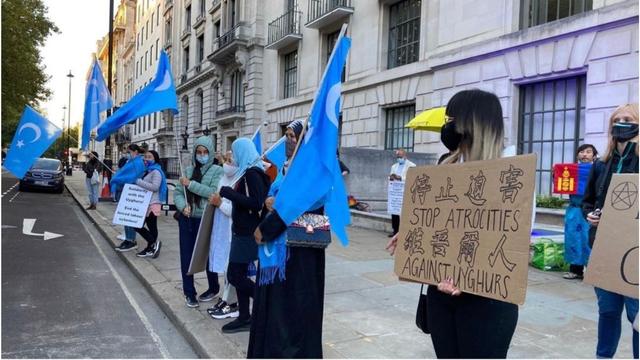Each year, protests in London commemorate the anniversary of the Shaoguan and Urumqi massacres. Source: Uyghur Solidarity UK.
The killing of Uyghur slave workers in Shaoguan, Guangdong, on May 26, 2009 was the cause of what happened in Urumqi on July 5.
by Abdurehim Gheni Uyghur
Bitter Winter, 07/06/2022
Every time, when we remember the Shaoguan Massacre, our resentment towards China worsens, not only for the numbers of victims but also for their painful death. Dozens of Uyghur slave laborers who were transferred from Konisheher County, Kashgar prefecture to Shaoguan City, Guangdong province, had never thought they would be painfully beaten to death on May 26, 2009.
On that day, thousands of Han Chinese workers broke into their dormitories and pulled them down from their beds. They beat them with wooden and iron sticks until some died. They accused them of flirting with Han Chinese female workers. The video clips of running Uyghur workers chased and viciously beaten went viral online.

Though I was living in Netherlands, I paid close attention to the news of East Turkestan (Ch. Xinjiang). The video clips of chasing and beating Uyghur workers were hotly debated online. According to statistics, 17 Uyghur workers died on that day.
In response to the brutal massacre, thousands of students, most of them very young, organized a demonstration in front of the government building of the so-called Xinjiang Uyghur Autonomous Region in Urumqi. They demanded that the government should give an explanation about the Shaoguan Massacre, stop forcible transfer of Uyghur laborers to Han-dominated provinces, and solve unemployment problems within East Turkestan. However, the police and army forces opened fire on the protesters, causing more casualties. The videos of police shooting towards protesters and police beating protesters also became widespread online.
During the protest, police forces and soldiers used newly developed sulfur guns that attach the protesters’ clothing and are impossible to wash away. After arresting them during the night, they checked the imprints left on the cloths to ascertain whether they had been part of the protest. Electricity was cut in the residential areas where Uyghurs were primarily residing, and the soldiers broke into houses and arrested and killed Uyghurs arbitrarily.
The video clips of Han Chinese beating and killing Uyghur slave workers in Shaohuan city were rather violent and disturbing, and they circulated on Internet for weeks, infuriating many Uyghurs. Curiously they had never been banned by the otherwise effective Chinese Internet police, even though they prove who initiated the riots.
More evidence clearly indicates that it was a political plot deliberately planned by the Chinese government. Several witnesses reported that the CCP regional secretary Wang Lequan and other officials were having fun at the tourist attraction called the South Mountain of Urumqi at the time when the police were using sulfur guns to mark protesters and arresting and killing them under the cover of darkness.
In the night of July 5, several Uyghur youths resident in Dong Kowruck (Erdaoqiao), Beige Meidani (Horseracing Road), Dawan Road (Hill Road) were killed. The bodies were shifted by army vehicles, and bloodstains were washed throughout all night under the cover of darkness.
Wang Lequan described this massacre on TV as “a strong strike back against radicals.” Inspired by Wang Lequan’s implicit guarantee of no punishment, thousands of Han Chinese descended on Uyghur densely resided areas and killed or injured all the Uyghurs they saw, by using wooden and iron sticks, without any interference by the police. A witness stated that 20-30 plainclothes policemen went on a rampage, killing even the elderly and the children. Not surprisingly, this exasperated the Uyghur feelings towards the Han, and was the root cause of the violence that followed.

When the July 5 massacre took place, the Chinese President Hu Jintao abruptly returned to Beijing from Italy where he was attending the G8 meeting and ordered a heavy crackdown. He also ordered to blame the Uyghurs for the riots.
Memetjan Abdulla, a reporter of China Radio International ( CRI), sentenced to life imprisonment in April 2010 for “instigating ethnic rioting” and for posting the World Uyghur Congress’s statement, called Uyghurs around the world to protest about the Shaoguan incident on the Uyghur-language website Salkin.
GulmireImin, web administrator for the Uyghur-language website and a government employee in Urumqi, was sentenced to life in April 2010 for posting calls for a demonstration asking justice on the Salkin website.
Geyret Niyaz, a classmate of former chairperson of the Xinjiang Uyghur Autonomous Region Nur Bekri’, and a former journalist at the Xinjiang Economic Daily, was sentenced to 15 years in jail for providing suggestions to the government about how to solve the problem and for accepting interviews from foreign journalists.
Ilham Tohti, an internationally famous professor of economics, and host at the Uyghur Onlinewebsite, was sentenced to life imprisonment on September 23, 2014, for “inciting separatism” after he had called for the respect of Uyghurs’ human rights. Tohti had criticized the Chinese government on the July 5 Massacre by saying, “This is not an incident but a result of the harsh politics of Chinese government towards Uyghur people.”
Sophie Richardson, the China director at Human Rights Watch, mentioned how China accelerated the militarization of the Uyghur region after the Shaoguan massacre and the Urumqi riots. She also showed admiration for the Uyghur people courage and bravery in facing oppression.
In the history of Chinese oppression of the Uyghurs, physical repression and even massacres are not incidents. They are part of a policy aimed at terrorizing Uyghurs, using various pretexts, with the final goal of eliminating them, if not physically, by destroying their identity and culture. The Shaoguan massacre was the forerunner of many others, and confirms that China fully deserves to be designated as a terrorist state.

